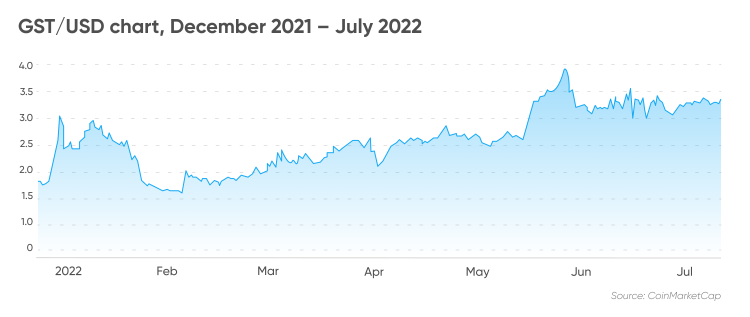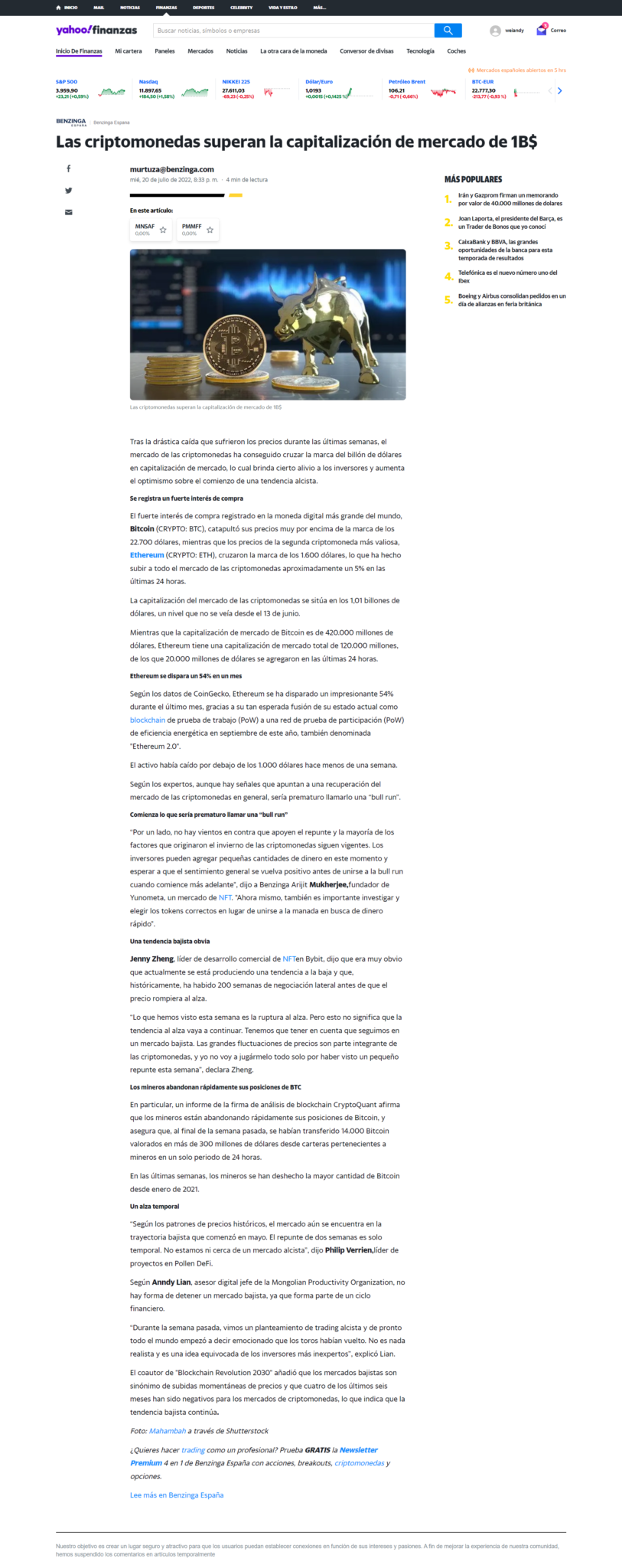The green satoshi token (GST) is the native cryptocurrency of the first-of-its-kind Web3 lifestyle app STEPN, which encourages users to stay active by rewarding them in GST tokens.
The token started 2022 with a kick, seeing its value surge by more than 300% from its debut in late December 2021 at $1.8 to an all-time high of $7.8 on 29 April 2022. Since then, however, the token dipped, losing over 99.7% of its gains down to $0.0223 as of 25 November 2022.
So, what is green satoshi token (GST) and how does it work?
What is green satoshi token (GST)?
A pioneer in the move-to-earn (M2E) sphere, STEPN inspires crypto fans to exercise or “move around” while earning the platform’s native coin – the green satoshi token (GST).
According to the STEPN platform’s whitepaper: “With Game-Fi, STEPN aims to nudge millions toward a healthier lifestyle, combat climate change and connect the public to Web 3.0, all while simultaneously hinging on it’s Social-Fi aspect to build a long-lasting platform fostering user generated Web 3.0 content.”
STEPN announced its public beta release on 20 December 2021 and was launched by the Australia-based fintech studio, Find Satoshi Lab.
Users get to purchase and equip themselves with non-fungible tokens (NTFs) in the shape of sneakers that are used for jogging, walking or running outdoors.
The game has four types of NFT Sneakers designed to fit different fitness levels. In addition, STEPN Sneakers are ranked by five different qualities that are given to them at random, thus establishing their rarity.
Users can purchase new Sneakers through the in-game NFT marketplace or create their own by “breeding” two Sneakers they already own through what the platform calls a Shoe Minting Event (SME). Each Sneaker can be bred up to seven times. The more a Sneaker was bred, the more tokens it will cost.
STEPN has three game modes.
- Solo Mode: Users are equipped with NFT Sneakers and can earn GST coins through either walking or running. Their progress is tracked via a GPS signal. Users are given a certain amount of energy which allows them to earn GST tokens. Once that energy runs out, tokens can no longer be earned.
- Marathon Mode: Users can participate in a weekly or monthly marathon of their chosen distance. At the time of writing, the marathon mode was currently under development.
- Background Mode: Users will be able to continue gaining GST tokens while the STEPN is running in the background. As long as a user owns an NFT Sneaker, the app will be able to collect the user’s step data from their mobile’s health app. At the time of writing, this mode was also under development.
How does green satoshi token work?
It is important to note that STEPN has a dual token system; the green satoshi token cryptocurrency and the green metaverse token (GMT).
The GST coin is the in-game token of the STEPN ecosystem, while GMT is its governance coin.
So, what is the green satoshi token used for?
GST has an unlimited supply and can be earned by users through moving. GST is paid out for every minute of movement. The amount of GST paid out to users depends on the type of Sneaker they own and its unique attributes.
Because STEPN was built on the Solana (SOL) ecosystem, the GST coin was introduced on the Solana blockchain and then in May 2022 also added to the BNB Chain (BNB), formerly called BNB Smart Chain (BSC).
GST can be notably considered one of the more successful cryptocurrencies of 2022, despite the overall bear market that followed most cryptocurrencies at the start of the year.
The coin surged by around 350% within four months from $1.7443 on 22 December 2021 to $7.8337 on 29 April 2022 – its all-time high – as the company pledged to combat climate change and achieve carbon neutrality through the purchase of $100,000 worth of Carbon Removal Tonnes and the GTS token was listed on the popular crypto exchange Coinbase.
The positive rally did not last long, however, and GST managed to lose over 45% of its gains overnight dropping to $4.121, ahead of the release of the platform’s Public Beta Phase IV. By 3 May 2022, the token managed to resurface, surging past $6.5.
As hype surrounding STEPN and its native cryptocurrency started to decline, and the economic situation worldwide deteriorated, GST embarked on a bear run, losing over 97% of its gains from its 3 May 2022 value, down to $0.1804 by 13 June 2022.
DappRadar’s third-quarter gaming report published in October 2022 noted that STEPN “has cooled down after a torrid Q2” and its monthly active users decreased by 67%, falling to 482,000. In comparison, during Q2, STEPN registered over 2 million monthly users and over 260,000 new wallets.
By 23 November 2022, GST lost an additional 87.6% of its price down to $0.0223.
Latest GST news and price drivers
STEPN was the first ever earn-to-move blockchain to be released and with no competition at the time managed to surge to certain heights. However, competition was inevitable with the release of Sweat Economy, another move-to-earn blockchain, which according to DappRadar minted a record-breaking 10,000 NFTs in September 2022.
Additionally, uncertainty surrounding the Solana blockchain has been on the rise since the FTX crypto exchange, which is closely tied to Solana, filed for bankruptcy on 11 November. Since STEPN was built on the Solana blockchain, the GST coin is also affected by either positive or negative movements in Solana’s native cryptocurrency SOL.
In other news, STEPN announced on 18 November that it has launched an in-app event to celebrate the FIFA World Cup, top international sporting events of 2022, and encourage users worldwide to move and participate.
Moreover, STEPN has also partnered with ASICS and Solana to “pave the way for the Web3 fitness industry” by launching a new UI sneakers Collection.
Risk and opportunities
Anndy Lian, the chief digital advisor at the Mongolian Productivity Organisation and author of ‘NFT: From Zero to Hero’ told Capital.com that GST being built on the Solana network is both a “risk and opportunity” for the token.
“More than $700m has exited Solana-based applications, a 70% drop from the $1bn in TVL on 2 November alone. And please be mindful that this is the beginning of the whole saga.
“If Solana can continue to function and ride through this massive blow, GST being one of the largest ecosystems on Solana would surely be the first few that will benefit from this; Proving to the world that decentralisation actually works this time.”
Crypto advisor Victoria Kennedy added that GST’s biggest pro is its current burn system, which sees more tokens being burned than released, thus keeping the green satoshi token cryptocurrency deflationary. However, she also noted that due to its massive use function within the STEPN ecosystem, the “selling pressure from the players is much bigger, thus pushing the price down”.
Dr Pooja Lekhi, the vice chair of the Department of Quantitative Studies at University Canada West said that the GST coin “is still very new in the crypto market and hence has a limited track record and has no traceable features on trading views”.
On the other hand, Dr. Lekhi noted that GST has certain unique features including “social and community aspects”.
Note that analyst views are not financial advice and shouldn’t be used as a substitute for your own research. Always conduct your own due diligence, and never invest or trade money you cannot afford to lose.
Source: https://capital.com/green-satoshi-token-gst-stepn-crypto-what-is-ultimate-guide


Anndy Lian is an early blockchain adopter and experienced serial entrepreneur who is known for his work in the government sector. He is a best selling book author- “NFT: From Zero to Hero” and “Blockchain Revolution 2030”.
Currently, he is appointed as the Chief Digital Advisor at Mongolia Productivity Organization, championing national digitization. Prior to his current appointments, he was the Chairman of BigONE Exchange, a global top 30 ranked crypto spot exchange and was also the Advisory Board Member for Hyundai DAC, the blockchain arm of South Korea’s largest car manufacturer Hyundai Motor Group. Lian played a pivotal role as the Blockchain Advisor for Asian Productivity Organisation (APO), an intergovernmental organization committed to improving productivity in the Asia-Pacific region.
An avid supporter of incubating start-ups, Anndy has also been a private investor for the past eight years. With a growth investment mindset, Anndy strategically demonstrates this in the companies he chooses to be involved with. He believes that what he is doing through blockchain technology currently will revolutionise and redefine traditional businesses. He also believes that the blockchain industry has to be “redecentralised”.





